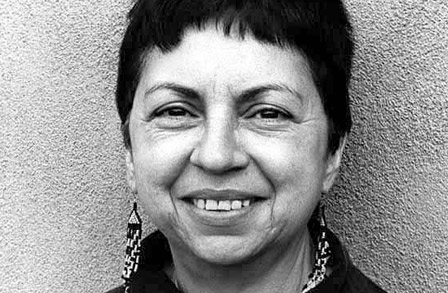For this Womxn’s history month, we honor Chicana writer, poet and theorist, Gloria Anzaldúa.
Gloria Anzaldúa (September 26, 1942 – May 15, 2004), was most famous for her books Borderlands/La Frontera: The New Mestiza and This Bridge Called My Back: Writings by Radical Women of Color, and wrote mainly on Queer Theory, Chicana Cultural Theory, and Feminist Theory. Texas born and self-identified as a Chicana/Tejana/lesbian/dyke/feminist/writer/poet/ cultural theorist/political activist, Anzaldúa is arguably the most famous Latinx lesbian writer of her time. Her works incorporate a lot of her own experiences with her multiple identities as well as developed theories encompassing folks of queer identities and those of mixed cultures that developed alongside the boarders, both physically, culturally and emotionally. Throughout her work, she exposes the power of people who hold multiple identities such as: sexual identity, race, culture, gender identity and expression and class.
Anzaldúa discusses the idea of ‘queerness’, not just in an identity politics sense, but in a personal, humanistic, deconstructive non-political aspect. She was politically active in her own sense, but was also a trailblazer for queer women of color and greatly contributed to speaking up and creating the space for Latina lesbians specifically. These political and academic platforms that give queer women of color a voice had never really existed before due to the oppression and exploitation of Mexican culture in America by white, heterosexual, cisgender men (and still exists today). This is evident through the lack of value and recognition for Mexican culture in this country due to the colonization, imperialism and oppression that this country was built on, and the patriarchal beliefs that exist as a product of the norms and standards created.
Moreover, Anzaldúa writes about the complexity of intersections of identity at hand when a person’s predominant identity isn’t just centered around their gender or sexuality, but the interplay of gender and sexuality within culture and race, and how they can never be separated, but are always in constant flux and feeding off of each other. As the LGBTQ community has historically consisted of predominantly white stories, Anzaldúa’s specific stories were the only exposure people had to a queer and intersectional understanding of history when they were first being publishing.
In essence, Anzaldúa’s work also encompasses the idea of queerness merely by existing in society and embodying certain identities, which inherently go against the patriarchy and dominant discourses in place. Queer theory, at its core, is the deconstruction and rejection of fixed identities that have been socially created and normalized in our society. Ultimately, Anzaldúa conveys through her work a sense of exploration of self outside of the binary, versus a creation of identity to fit the already formed social constructs that exist.


